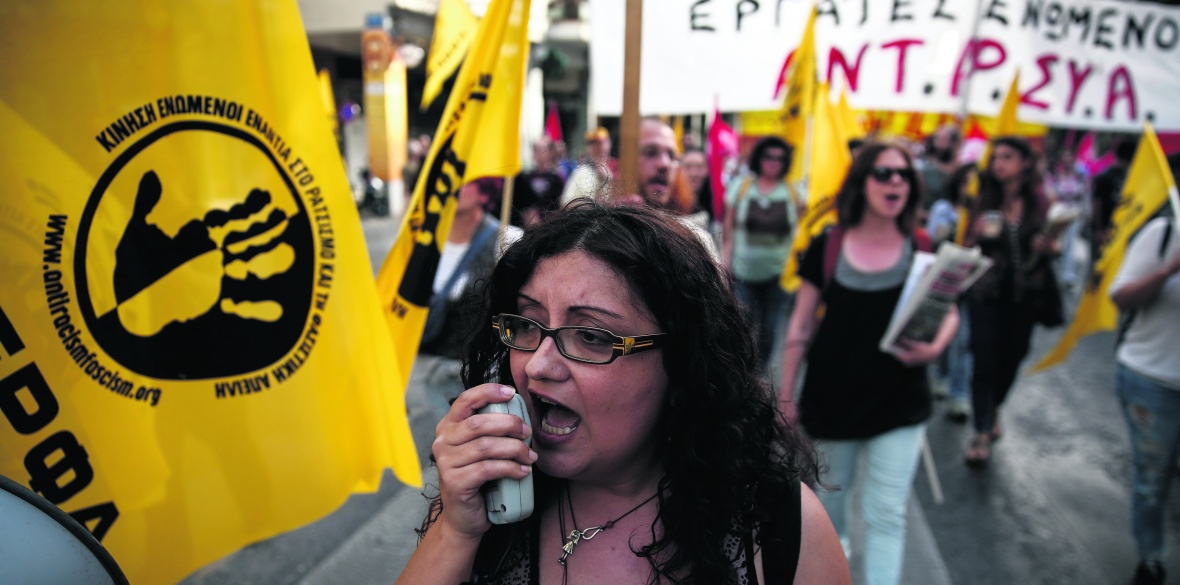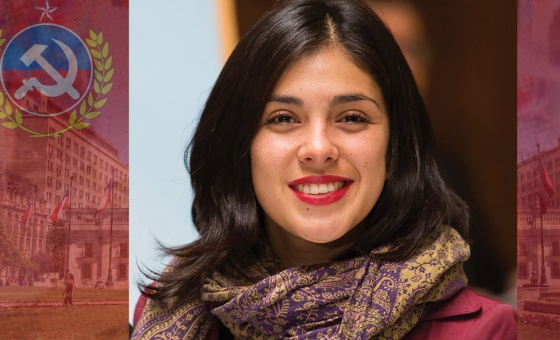This is the last article you can read this month
You can read more article this month
You can read more articles this month
Sorry your limit is up for this month
Reset on:
Please help support the Morning Star by subscribing here
THIS year sees the British far right in many respects at their weakest for over a decade.
Boris Johnson’s positioning of the Tories to the right over Brexit, his attacks on “lefties” over the London Bridge terror attack and the refusal to reunite child refugees with their families are grist to the far right’s mill.
They reflect the reactionary heart of a Dominic Cummings-run No 10. Such moves have however reduced the space for the far right.
Fascists such as “Tommy Robinson” and street thugs like the much-weakened Democratic Football Lads Alliance (DFLA) back Johnson.
This says much about how far to the right the Tories have gone. Last year, Johnson’s and Robinson’s names were chanted by fascists.
The previously most right-wing Tory prime minister, Margaret Thatcher, was hated by the National Front for adopting some of their rhetoric.
Now Johnson is seen by the far right as “one of them.” Though they are obviously not fascists, Johnson and Donald Trump’s racist populism appeals to the far right.
Following Johnson’s victory, much of the British far right see street mobilisations as less critical. It has a certain logic.
Why mobilise if someone like him is prime minister? Many in the far right see little need to “get on the streets,” given the nature of the Prime Minister’s trajectory.
State racism, for instance over refugees, highlights Tory callousness. Their actions regarding the Dubs amendment outlines what will follow if the Tories get away with it.
Johnson’s attacks on the “liberal elite” echo one-time BNP leader Nick Griffin’s lamentations. Emboldened by Johnson’s Brexit rhetoric, racists voice their filth assertively, and Islamophobic and anti-semitic attacks are on the increase.
However, the current impasse of the far right in Britain is not wholly down to Johnson, of course.
Internationally, the far right is strong and powerful in several states, for example Hungary, whose leader Viktor Orban, though notorious for his anti-semitism, was recently praised by a Johnson adviser.
Marine Le Pen in France, despite the incredible yellow vests movement, remains part of the political furniture.
She won last year’s Euro elections, where the far-right German AfD and the governing Polish PiS also made gains. (Possibly 40 per cent of AfD members support the fascist “Wing” faction, which contains Hitler admirers. Poland of course sees tens of thousands of the far right march every November on Independence Day).
The far right has been pushed back in some states, such as Greece. The nazi Golden Dawn was once Greece’s third-largest party.
Now, it is shattered. It has lost all parliamentary representation, has no offices and many leaders and officials face jail. United anti-fascist work did for them.
Sadly, Greece and Britain are rare exceptions. The list is long of nations where the far right and nazis have a large electoral base and/or have street mobilisations, such as Ukraine, Austria, Brazil and Germany. Slovakia’s elections next month may see the fascist LSNS (People’s Party — Our Slovakia) come second.
Inspiring much of the far right globally is Trump. His “America first” stance and anti-refugee acts continue to open avenues for nazis and racist populists.
The networks between the far right are many and varied. Ex-Trump chief strategist Steve Bannon’s university for far-right cadres in Italy was pulled, but his ideas grow.
Bannon’s “Movement” was stillborn but he and Breitbart News’s talk of “ethnopluralism” is now heard at government levels in parts of Europe. That’s how far we have come regarding the normalisation of far-right ideas.
Italy’s Northern League, France’s Rassemblement National (formerly the National Front) and Spain’s Vox party look to further cement their growth internationally.
Fortunately, there is increasing anti-fascist resistance. In Italy the “Sardines” movement has electrified opposition to Matteo Salvini and the Northern League.
There is contestation in the movement, as elsewhere, but the size of the movement has rejuvenated Italian anti-fascism.
Britain two years ago saw the biggest-ever march for a fascist to take place in London, when thousands turned out in support of Robinson.
Stand Up To Racism/Unite Against Fascism, like others, were deeply worried at the threat the far right posed.
Our warnings about a growing fascist street force, aligned with Ukip, made sense to wider forces, following the extreme right’s summer 2018 “free speech” (sic) event.
Then, the 10,000-plus march for Robinson over his imprisonment sent shockwaves through the movement.
DFLA thugs attacked prominent trade unionists, the left-wing Bookmarks bookshop in London and Stand Up To Racism events.
Fascists sometimes clashed with those who led the “Free Tommy” marches. Many nazis tried to push for hegemony of the events and narrow those attending to the ideologically pure. They had some success.
The forces on those gatherings saw large numbers of open fascists such as the National Front, BNP and Generation Identity members.
A US ambassador even expressed support for Robinson. These were not the bozos who regularly intimidated MPs and campaigners at Parliament over Brexit.
It was a movement with international support and funding. But like many movements, it has gone up like a rocket and down like a stick. For now…
It’s believed that anti-fascist activities at street level and at football grounds have helped to isolate the far right.
The last few turnouts by them show their current impasse in Britain. The largest recently was a Britain First conference, but it was only 60-strong. Fascists from various sects will be at Westminster on the day Britain leaves the EU. But their numbers do not promise much and figures like Robinson are concentrating on legal matters.
The 2019 “Free Tommy” demos were reduced to the hard core — although it should be noted that, as writer Louise Raw has documented, the Met Police facilitated a public speaking stage at one of their protests outside the Old Bailey.
Overseas money men (they’re usually men) have currently abandoned Robinson. Instead, social media lightweights are Robinson’s outriders and their amateurism is legendary.
Informed sources say that Robinson faces up to six court cases. Little wonder that his support base has declined. He has previously claimed he’ll be speaking at the European Parliament in an effort to stay relevant.
However, erstwhile allies have abandoned him and many street thugs distrust him. Robinson’s online appearances summed up his current isolation and having his social-media profile susbstantially curbed has hit him.
None of this was inevitable. Ukip, now treading water, threw in its lot with Robinson and the DFLA.
A march in Sunderland in 2018 saw Gerard Batten and the DFLA together, in an ugly expression of their street/electoral aims.
Ukip’s lash-up with such groups and Robinson aimed to replicate success from similar ventures such as the AfD’s growth from the anti-Islam, Pegida movement.
Ukip’s inability to follow in the footsteps of the AfD was no forgone conclusion and owed much to exposure and campaigning by anti-fascists.
Moreover, various splinter groups from the English Defence League have no social base and the EDL itself, once a threat, is dead. Just four turned up at a recent anti-war London demonstration.
December’s Trump visit to London saw two rival fascist “firms” look to attack anti-Trump demonstrators. One group regretted its efforts while another, linked to the DFLA, also came unstuck, at the hands of the police.
Great credit must go to those in north-west England who stopped Robinson’s electoral ambitions in the Euro elections last year.
The broad-based campaign, rooted in the labour movement, came from years of consistent, anti-fascist work led by the local Unite Against Fascism organiser.
Despite these successes, we should remember that the ideas Robinson popularises have murderous effects — inspiring the actions of, for example, Darren Osborne, the Finsbury Park mosque murderer.
Robinson’s parroting of the fascist “great replacement theory” has been adopted by powerful actors like Orban and Salvini. Fascists will also look to mobilise around any terrorist acts.
But the British far right lacks cadres and has suffered defeats. On one day recently, four National Action members were in court, a fascist was jailed for terrorism and nine Robinson supporters were charged over violence.
Generation Identity has suffered splits and arrests, due to links with the Christchurch mosque murderer. And ex-BNP official Larry Nunn, who wanted to use his funds to reinvigorate British fascism, is off the scene. The attempt by the London Forum group to form “political soldiers” has also collapsed. Such people and groups will look to reassemble but they are weakened and biding their time.
So as we head towards the 75th anniversary of the liberation of Auschwitz it’s timely to seriously examine the threat the far right poses internationally and here.
The 43 Group’s motto of “On guard” still holds. The Stand Up To Racism demonstrations on March 21 will be an important moment to broaden the forces that can stop fascism here and elsewhere.
Paul Sillett is Unite Against Fascism national campaigner.












